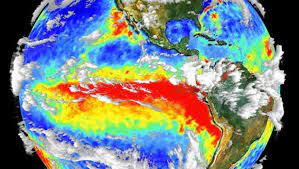By Rhodilee Jean Dolor
El Nino to Intensify Effects Of Climate Change
Climate scientists sound the alarm that the looming return of El Niño and the worsening climate change could bring record-breaking temperatures in the next five years. Experts in the field warn that the weather phenomenon could intensify heat waves and leave profound impacts.
El Niño is the warming of sea surface temperatures in the central-east equatorial Pacific region. The weather phenomenon, which occurs every few years, manifests when sea temperatures in the tropical eastern Pacific increase by 0.5°C above the long-term average, causing warmer weather conditions.
Scientists say that the weather pattern could worsen global climate. A World Meteorological Organization (WMO) report indicates that global temperatures will rise to record levels between 2023 and 2027 due to the naturally occurring El Niño and heat-trapping greenhouse gasses that cause climate change.
Researchers estimate a 66% increased likelihood that the annual average near-surface global temperature will rise to more than 1.5°C above pre-industrial levels for at least one year in the next five years. They also anticipate a 98% chance that the years 2023 to 2027 and at least a year in this period will be the warmest on record.
“Global mean temperatures are predicted to continue increasing, moving us away further and further away from the climate we are used to,” said UK’s Met Office scientist Leon Hermanson.
Among the most immediate concerns stemming from the combined effects of the El Niño phenomenon and climate change is the impact on public health.
Heatwaves associated with El Niño events can be deadly, especially for vulnerable members of the population: the elderly, young children and those with health conditions. As temperatures rise, prolonged exposure to extreme heat can lead to heatstroke, dehydration, respiratory issues, and other potentially fatal health problems.
A Matter of Life and Death
In a 2018 study published in the journal Nature Climate Change, Stanford economist Marshall Burke and colleagues found that a 1°C rise in average temperatures in the U.S. and Mexico is associated with increased suicide incidents, which translates to thousands of additional deaths per year.
By analyzing more than 600 million social media updates, Burke’s team also found that people’s mental well-being tends to deteriorate during warmer periods. The findings of the research suggest that the scorching heat poses dangerous risks to mental health.
“We project that unmitigated climate change could result in a combined 9–40 thousand additional suicides (95% confidence interval) across the United States and Mexico by 2050, representing a change in suicide rates comparable to the estimated impact of economic recessions ” the researchers wrote.
Trillion-Dollar Problem
The warmer climate and its effects also cause massive financial losses worldwide. Researchers of a study published in the journal Science in May found that the effects of El Niño are far more expensive and have longer-lasting costs than previously believed.
Christopher Callahan and Justin Mankin, from Dartmouth College in Hanover, New Hampshire, looked at the long-term costs of El Niño. They found that its financial toll can persist for several years even after the weather event is over, costing trillions in lost income worldwide.
“El Niño persistently reduces country-level economic growth, attributing $4.1T and $5.7T in global income losses to the 1982–83 and 1997–98 events, respectively. Increased ENSO amplitude and teleconnections from warming cause $84T in 21st-century economic losses in an emissions scenario consistent with current mitigation pledges.”
The agricultural sector is particularly at risk of financial losses as crops face heightened stress because of the extreme heat leading to reduced yields, decreased crop quality and higher susceptibility of plants to pests and diseases.
In a 2019 study published in Science Advances, Weston Anderson, from the International Research Institute for Climate and Society, Palisades, and
colleagues showed that El Niño can cause devastating crop failures in different parts of the world.
“We find that the El Niño Southern Oscillation (ENSO), the Indian Ocean Dipole (IOD), tropical Atlantic variability (TAV), and the North Atlantic Oscillation (NAO) together account for 18, 7, and 6% of globally aggregated maize, soybean, and wheat production variability, respectively,” Anderson and colleagues wrote.
The findings indicate that El Niño’ can influence crop yields and significantly impact the livelihood of farmers.
“In 1983, ENSO, the only mode capable of forcing globally synchronous crop failures, was responsible for the largest synchronous crop failure in the modern historical record.”
Elevated temperatures also have far-reaching economic impacts on the younger generations. According to a report from the US Environmental Protection Agency’s Office of Atmospheric Protection (OAP), temperature increases of 2°C and 4°C are associated with 4% and 7% reductions in academic achievement per child, respectively. The report said that children may see reduced earning potential as adults due to heat-related learning losses.
“The total lost future income attributable to these learning losses may reach $6.9 billion ($1.9 to $12.7 billion) at 2°C and $13.4 billion ($8.9 to $18.3 billion) at 4°C,” the report read.
Wading Through the Climate Crisis
Amid rising temperatures, the best recourse for the world’s population is to adapt to the evolving climate conditions.
Although expensive for some, air conditioners and similar devices alleviate heat in indoor spaces. Farmers can also implement measures such as using heat-tolerant crop varieties and modifying irrigation practices to mitigate the impacts of climate change and El Niño. Countries can devise contingency plans to deal with the dangerous consequences of record-breaking temperatures.
Still, the collective effort of governments, industries and individuals is required to reduce greenhouse gas emissions, transition to renewable energy sources and engage in sustainable practices.
While the El Niño event is a natural occurrence, climate change is thought to be primarily caused by man-made activities. Only through a global commitment to address the problem can the world effectively avert disasters that may arise due to a warming planet.









